The first Alfa Romeo Giulia GTA (Type 105) was developed by Auto Delta and shown to the world in 1965 — the Giulia GTAm would appear four years later. The project was conducted at the Balocco workshop and test track (opened four years earlier), just over half an hour southwest of Milan.
And it's precisely under the same roof that I meet the Alfa Romeo Giulia GTA and GTAm from 2021, a racing car with authorization (and competence) to go on the road, which will have a production limited to 500 units and prices to match — 215 thousand and 221,000 euros in Portugal, GTA and GTAm respectively — with this exclusivity.
It is worth remembering what the Giulia meant for Alfa Romeo. Appeared in 2016 to raise the dynamic competence of Italian cars and with the formula “front engine-rear wheel drive” that already characterized the original model, from 1962.

Yes, because it wasn't for lack of “physical attributes” that Alfa Romeo reached the situation it lives in today (only two models and annual sales of 50 000 units, when in the distant 80's it reached 233,000 registered in a year), even because commercial failures, already during this century, have always been highly praised for their design.
But for a car to be successful it is not enough to have a seductive appearance, it has to have content and in this both the general quality and the concept of interiors and engineering did not know how to keep up with the best that appeared in the well-equipped competition, mainly German.
The Giorgio rear-wheel drive platform gave the Giulia and later the Stelvio — the only two current models — an important qualitative leap at all levels.

Alfa Romeo Giulia GTA
GTA, seduction with aggression
As usual, the Giulia seduces with its triangulated shield serving as a grille, flanked by slender headlights, the almost promiscuous fusion of concave and convex shapes in the body profiles and the massive rear, marked by the wide C-pillar.
And, of course, in this GTA version the final design result is even more impressive, thanks to the widening of the bodywork and the “additions” in carbon fiber, as in the splitter under the front bumper that advances 4 cm and lowers to improve the aerodynamic load: “80 kg ahead at maximum speed”, as explained to me by Daniel Guzzafame, GTA development engineer.
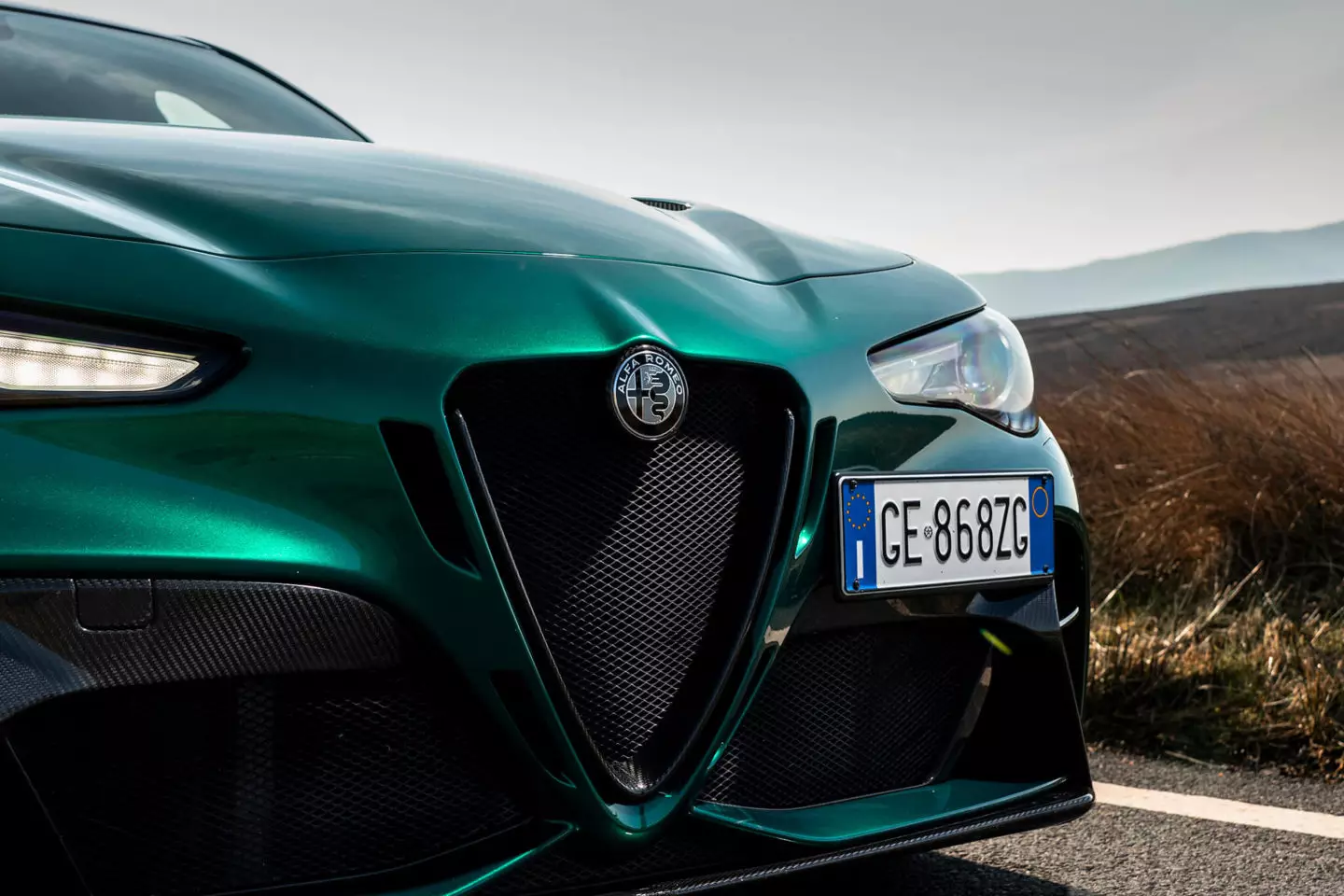
It can be seen that the car is more muscular than the already “exercised” Quadrifoglio, noting the extensive carbon fiber profiles in the front air intakes (larger, to bring 10% more airflow for engine cooling ), on the flanks next to the front wheels, in the wheel arches in order to reduce the mass of the car.
The “slimming” goal (after all, GTA stands for Gran Turismo Alleggerita) has also led to the adoption of polycarbonate rear windows and rear window (in the GTAm), composite door panels, lighter suspension springs and seats from the Sabelt also in carbon fiber.

Partners with competition genes
The rear diffuser is adorned with two imposing titanium center tailpipes bearing the prestigious Akrapovič signature, and the massive rear wing is carbon fiber and capable of pushing the GTA into the ground with another 80 kg of aerodynamic load.
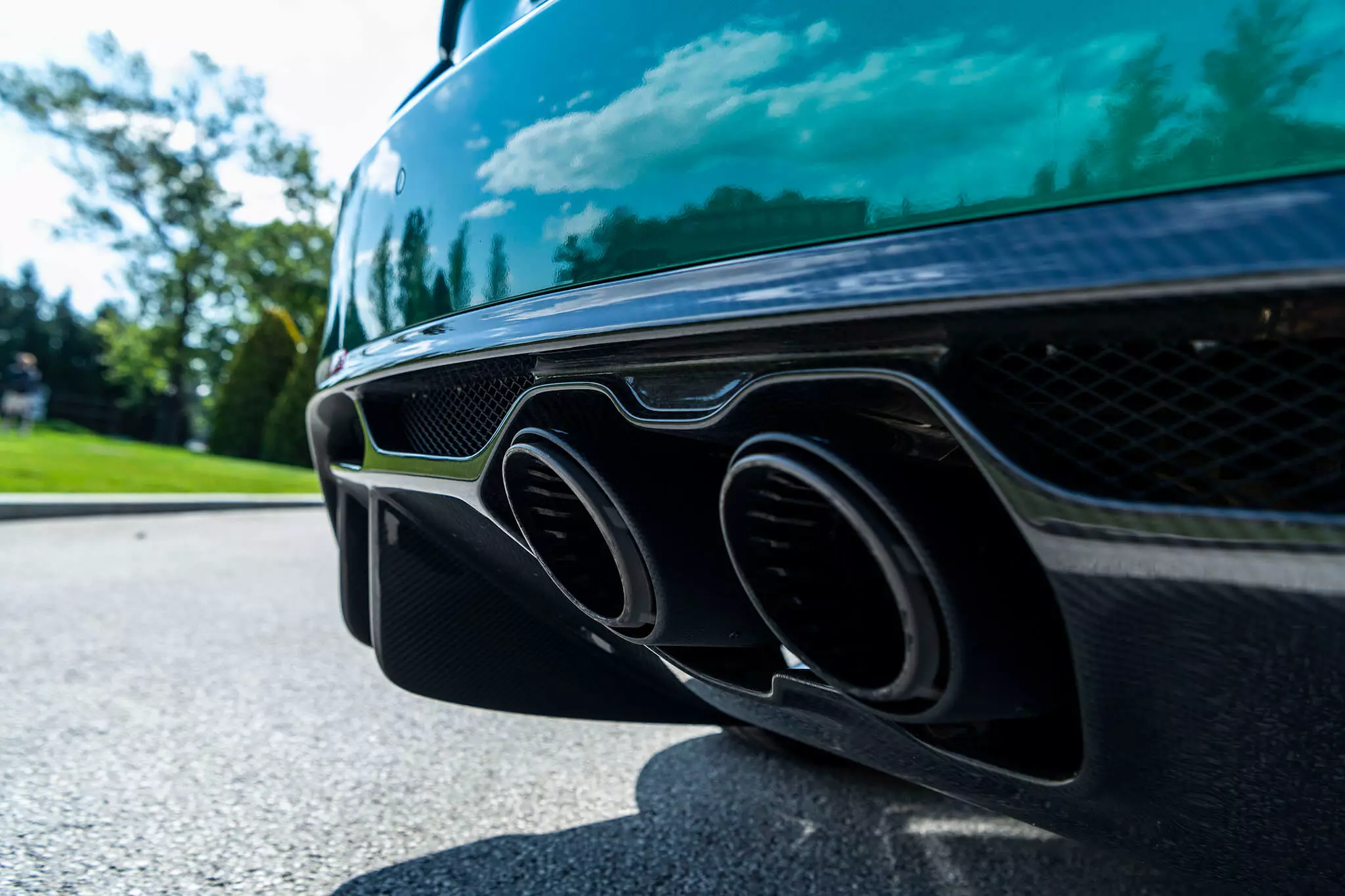
The generous pneumatic equipment is a sensational Michelin Pilot Cup 2, with two distinct rubber compositions, which feel “at home” on the track as well as on public asphalts — and that's why they cost almost 500 euros each… —, the wheels are made of 20″ and the fact that we are facing the only series-production sedan with a single-bolt nut help to create the certainty that we are facing a “beast” at the first glance.
And the carbon-ceramic brakes — which on the Quadrifoglio are optional at a cost of around 8,500 euros — just confirm this, as does the Sauber Engineering signature, on both sides next to the rear wheels, indicating the company's 50 years of experience Swiss car racing (half of which in Formula 1) were used to improve the GTA, even with direct contributions from official Alfa Romeo drivers Antonio Giovanazzi and Kimi Raikkonen.
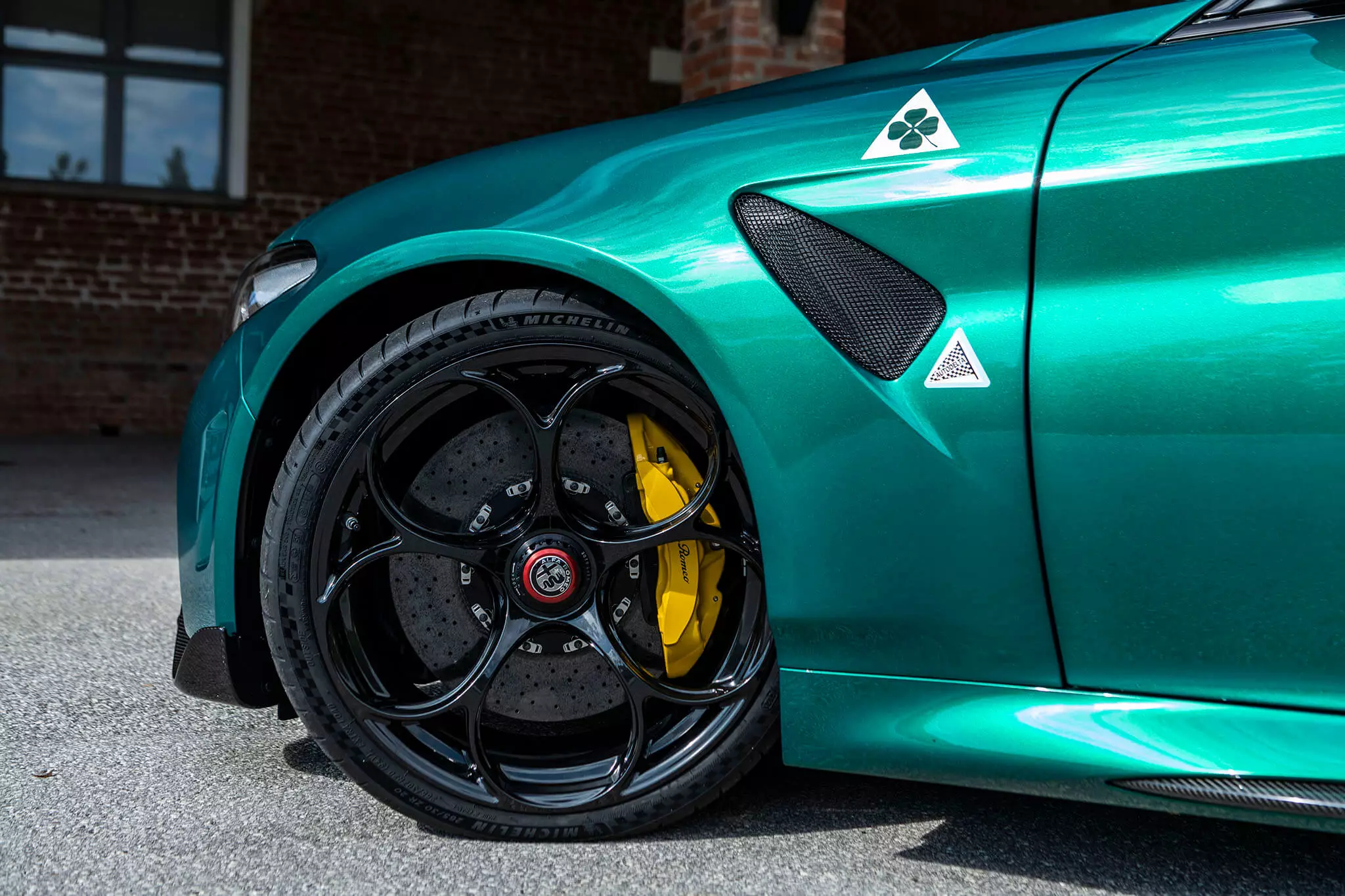
Gourmet suede until out of sight
The same racing environment marks the entire interior in both versions, but even more “drama” in the GTAm, which does not require the rear seats (in place of which there is an Alcantara-covered bench for two helmets and also the fire extinguisher) and assembles competition drumsticks, with carbon fiber structures, also covered in the same type of “gourmet suede” as the Alcantara (to prevent the occupants' bodies from sliding with the intensity of the “g”) and harnesses with six points of fixation.
The dashboard is similar in both cases, partially covered with Alcantara to avoid many reflections from the incidence of light, noting the seams in the exterior color of the bodywork (which, unless the customer requires, can only have three colors: green , white or red… the colors of the Italian flag). But the objective of subjecting the GTAm version to an even stricter diet (it weighs 100 kg less than the Quadrifoglio and 25 kg less than the GTA) even justified the replacement of the door handles by straps with the same function.
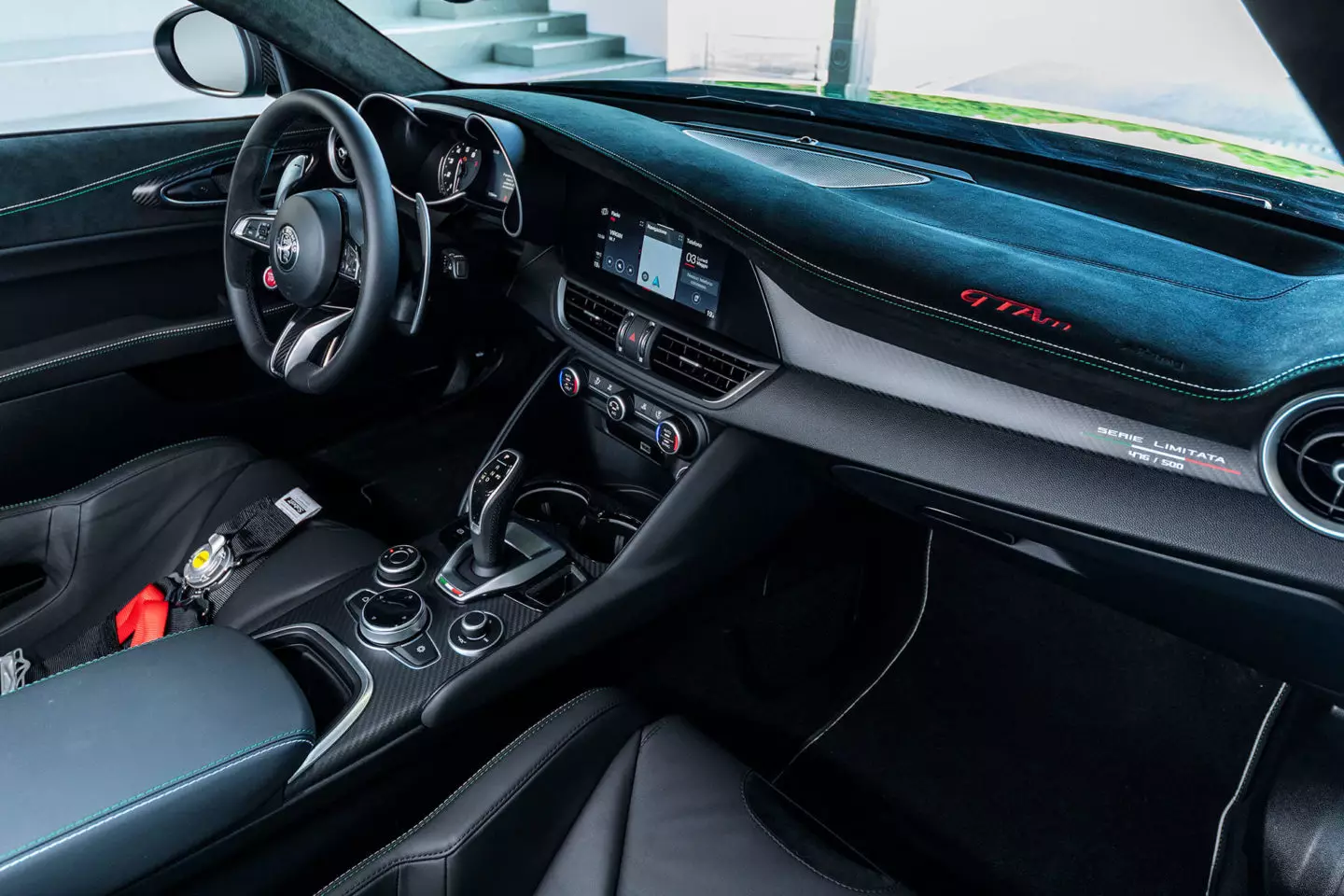
The materials are of average quality, as are the finishes, better than some generalist brands, worse than some premium ones, but the infotainment screen is small and the navigation system always seems to be one step behind what it should be (which in situations where we don't really know the roads we're on, it makes the difference between following the desired route and getting lost, as was the case…).
Transmission convinces more
Seats include audio volume control, another rotary for selecting driving modes and an even bigger one for controlling infotainment, in addition, of course, to the ZF eight-speed automatic gear selector with torque converter, with manual passage position (“minus” up and “plus” down”).
A specific calibration was made for this transmission, so that it could extract how much the engine has to give and with higher passing speed, which can be less than 150 milliseconds when selecting the Race driving mode. When in this mode the responsiveness of the active rear differential and the stiffness of the suspension are ready for “war”, plus the stability control hibernates until a threat to lose it wakes you from deep sleep.
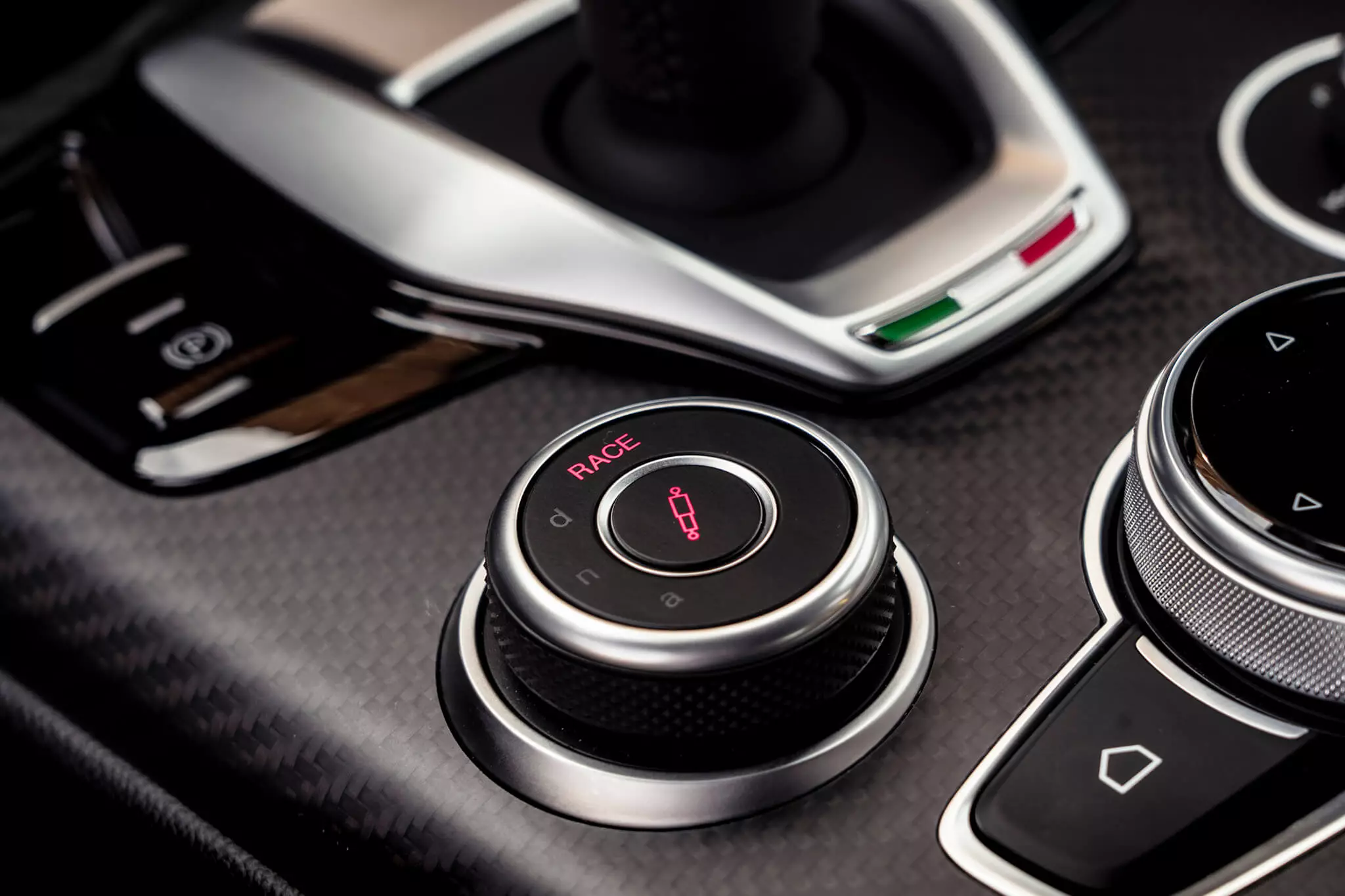
The handling of the gear is even more convincing with the conveniently large gearshift paddles (aluminium) mounted on the steering column, even though it doesn't match the brilliance of the Porsche PDK transmission.
Wake up the V6
Repairs to some of the interior aspects take on a stinginess when I wake up the engine with a slight pulse of the ignition button. The resulting roar seems to indicate that there were few hours of sleep, while at the same time revealing talented "low", albeit with frequent attacks of phlegm (in sportier driving modes), from what is the main calling card of the GTA: Or hadn't this engine been created by engineers “on loan” from Ferrari.
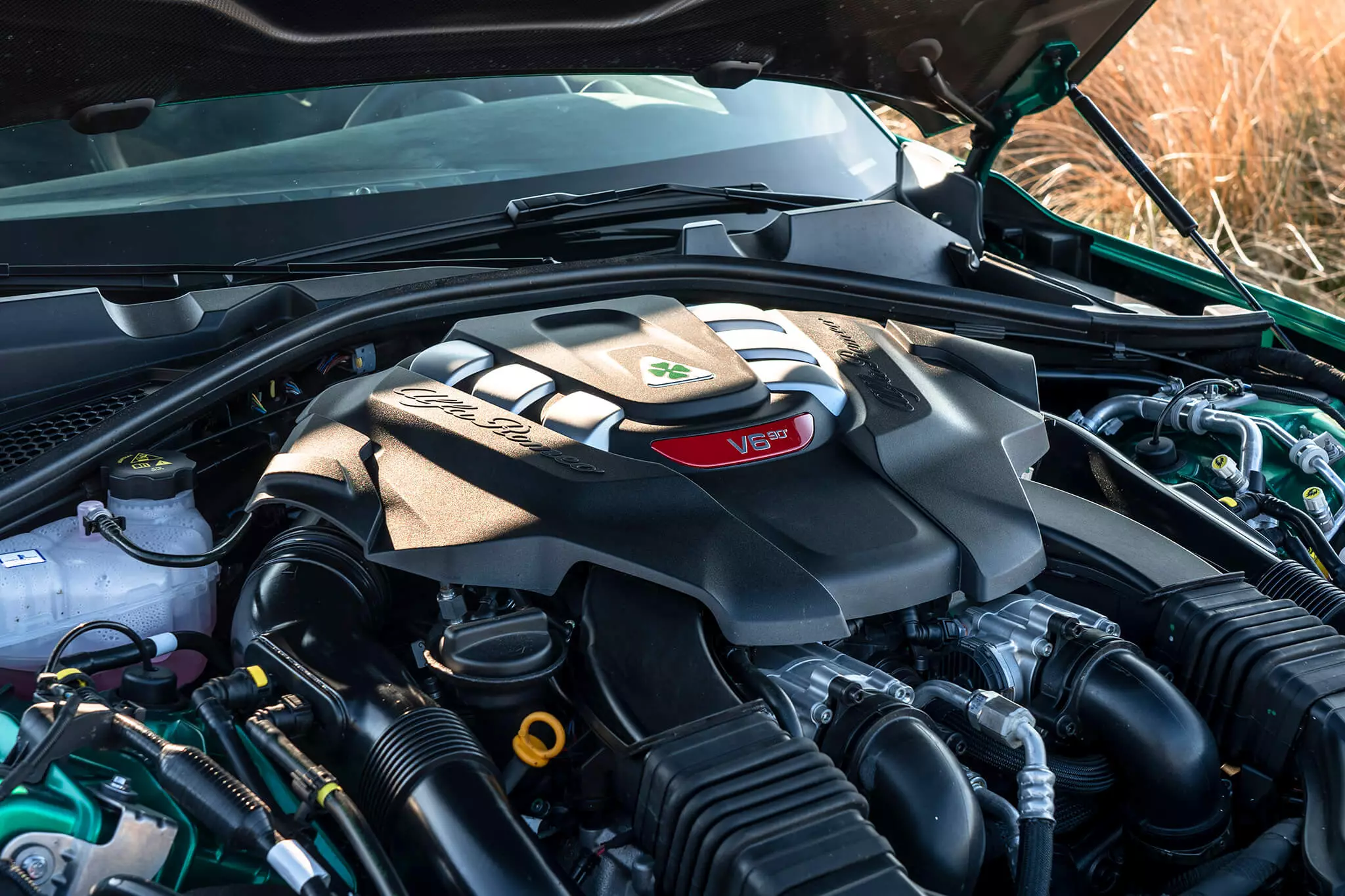
One of them, Leonardo Guinci, Alfa Romeo engine engineer, at the time of the world launch of the Stelvio Quadrifoglio (which uses this same engine) acknowledged that “the assembly of the turbos in the center of the V of the cylinder banks is being studied, which would allow time even faster response”, as already exists in some German proposals.
Guinci also explained to me that this V6 actually results from the "gluing" of two three-cylinder engines, each with its own turbo (small, low inertia, to avoid response delay) and other specific components, in double. The technological arsenal of this V6 is further illustrated by the deactivation system of one of the cylinder benches at low accelerator loads and without the driver being able to notice it, sensory or acoustically (even with “physical” ears).
In practice, it cannot be said that consumption is much less aggravated, because even without great exaggerations I ended up taking the test route on public roads reaching 20 l/100 km...

German rivals back
But the technical sheet of the 2.9 V6 (which has new connecting rods, plus two oil jets for lubrication and a new mapping), all in aluminum, is really impressive and if the Quadrifoglio has already equaled the best that is made by the German industry with the its 510 hp (read Mercedes-AMG C 63 S and BMW M3 Competition), now manages to take off and occupy the perch (destined for the most powerful car in the class) alone, with no less than 540 hp (a specific power of 187 hp/l) and 600 Nm (in this case beaten by the BMW with 650 Nm and equaled by the C 63 and the Audi RS 5).
And if the highest power we add the lowest mass (1580 kg in the GTAm, 25 kg less than the GTA, and against the 1695 kg of the Giulia Quadrifoglio, the 1755 kg of the C 63 S, the 1805 kg of the M3 Competition and the 1817 kg of the RS 5) so we should prepare for ballistic performances by the new kid on the block.

But here there is some disappointment, even taking into account that we are at a stratospheric level, as the 300 km/h of top speed is lower than the 307 km/h of the Giulia Quadrifoglio (none of them has the electronic gag of the German rivals, who ask for an extra value to be released) and the unrestrained sprint up to 100 km/h takes place in 0.2s less than in the M3, in the RS 5 or Giulia Quadrifoglio and in 0.3s less than in the C 63 S.
And, compared to the Giulia Quadrifoglio, the GTAm I drove only gained four tenths of the starting kilometer (21.1s vs 21.5s) and four tenths of 0 to 200 km/h (11.9s vs 12.3s). Less than expected. Only in the recovery of 80-200 km/h (8.6s vs. 9.3s) the difference is more expressive.

At the wheel
There are four driving modes that can be selected using the DNA switch: Dynamic, Natural and Advanced Efficiency (as in all Giulia models) and Race, which is specific to the tougher versions, which disables the stability control system completely , something suitable only for graduated pilots, because at really fast paces any tighter curve is a pretext for the rear end to come loose, like a dog's tail in a demonstration of happiness when seeing its owner.
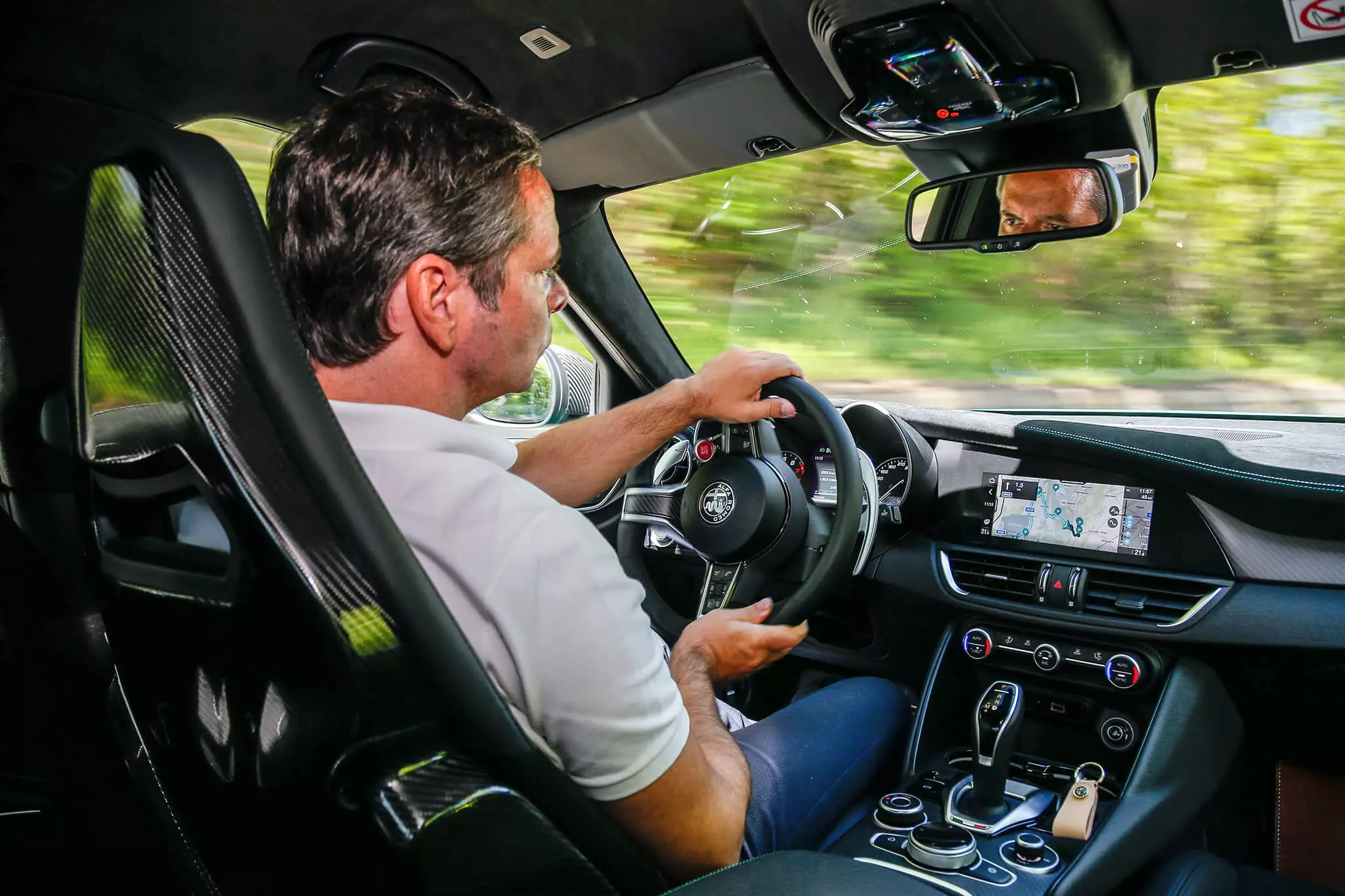
More prudent (almost mandatory if you're driving fast on an “open” road), then, is to activate the Dynamic mode, which keeps the electronic assistance in a “watchful” state for more delicate moments and also has the combined action of the system of torque vectoring and with the rear (mechanical) self-locking to authorize “drifts” controlled in corners, but with a much greater degree of certainty that they end well.
In the kilometers done on mountain roads, not always regular, it was possible to notice that the suspension manages to guarantee a very good level of comfort, this being one of the great dynamic surprises of the Giulia GTA and Giulia GTAm.
On the chassis, the tracks were widened (5 cm at the back and 2.5 cm at the front) because the requirements for the rear suspension (multi-arm independent axle) are great because the steering (2.2 turns of the steering wheel from top to top) is so fast and accurate and because the front axle itself (with double overlapping triangles) has surgical rigor when entering corners.
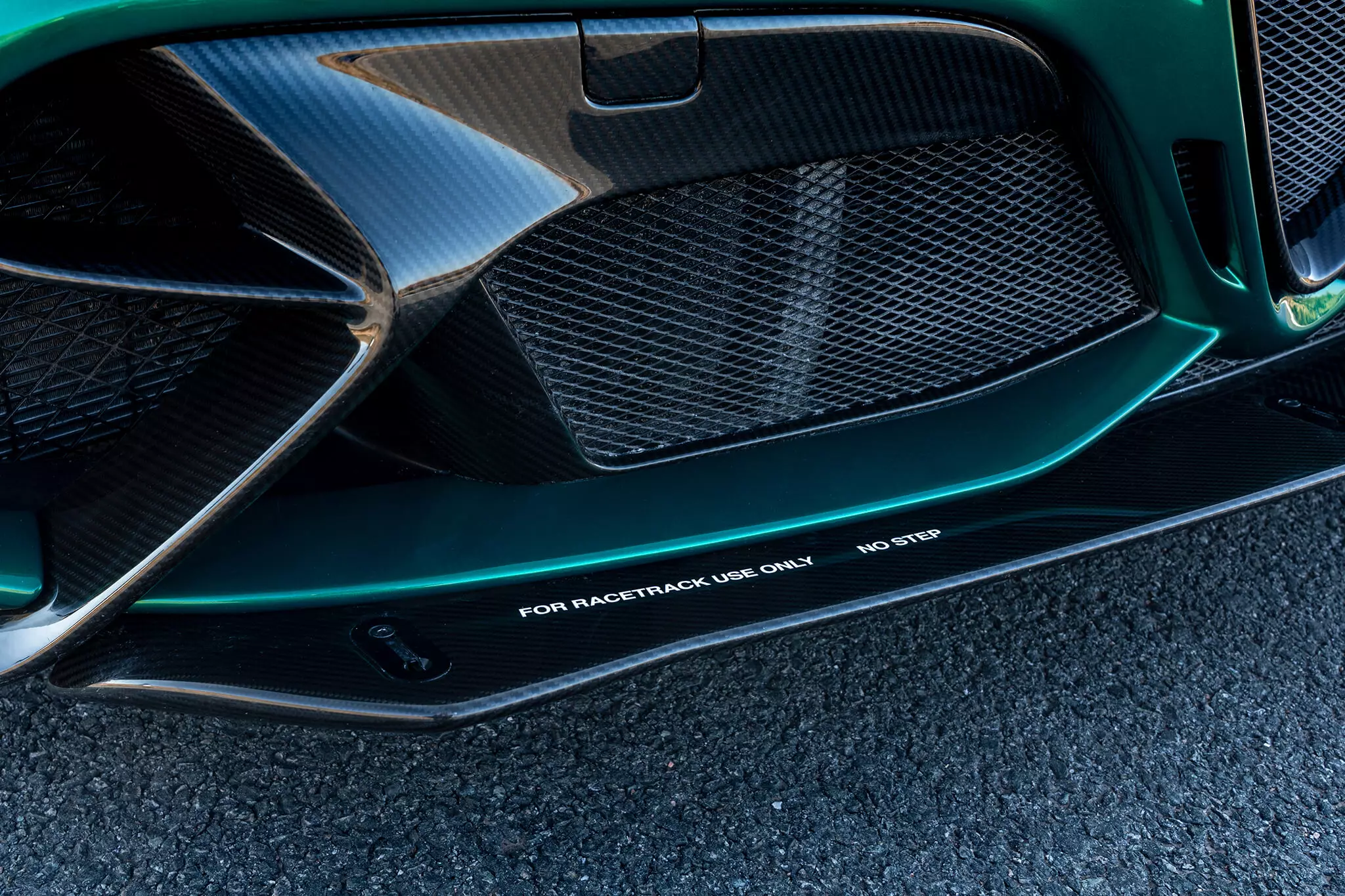
It is also the result of active aerodynamics — the aforementioned movable element in carbon fiber on the lower part of the front bumper — controlled by the electronic command of the CDC (Chassis Domain Control) system that also manages the distribution of torque by the wheels of the rear axle or the variable damping firmness.
Advantageous aerodynamic load on runway
Also for this reason, the rear wing (with four manually adjustable positions) unique to the Giulia GTAm is of such crucial importance. Brakes with ceramic discs were always tireless and with a readiness and power to “bite” anyone astonished.
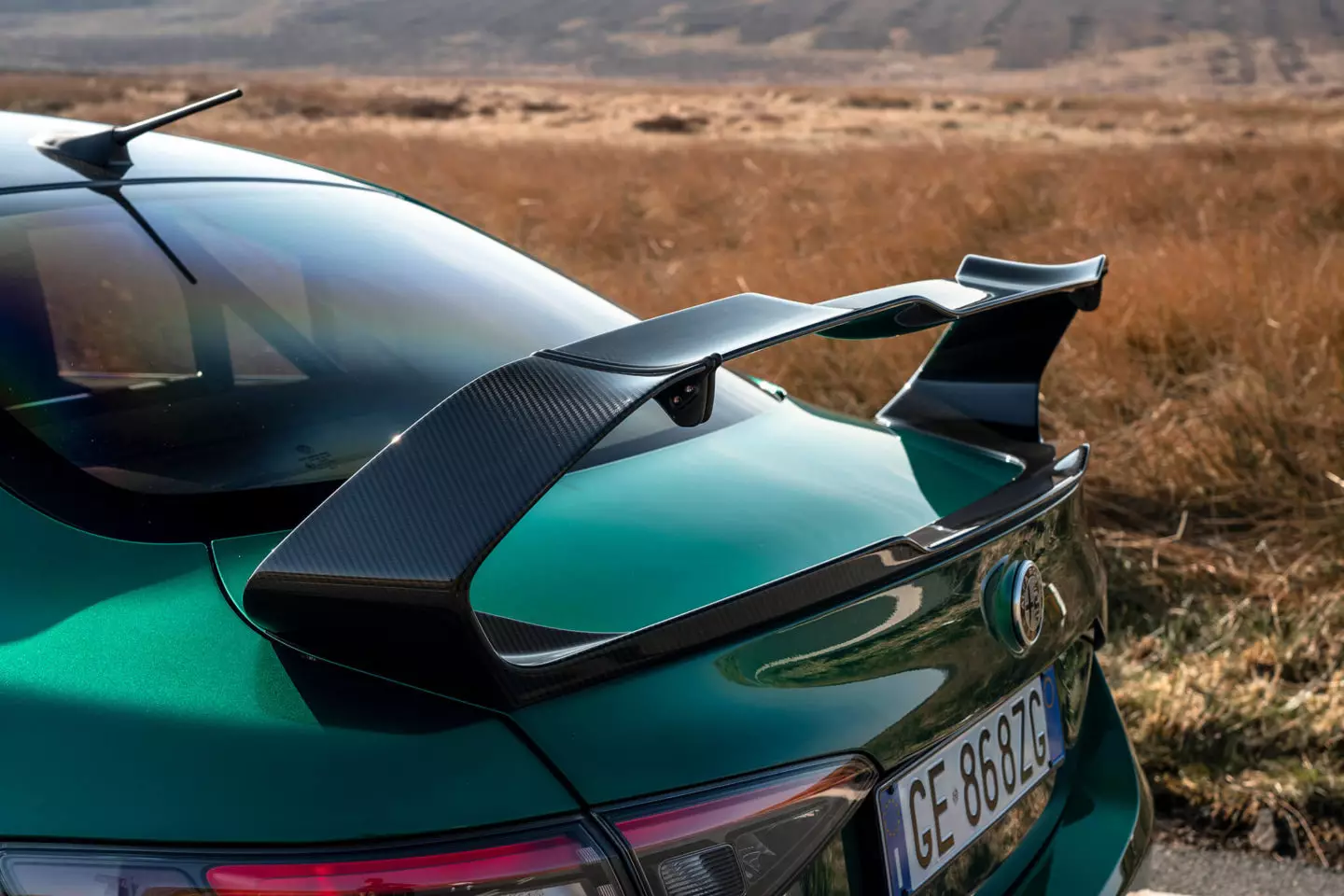
The rear wing is adjustable...
If the Giulia GTAm does not dig a relevant gap for the Quadrifoglio in quantitative terms, will it be able to do so in the qualitative assessment? The answer is yes: anything that pushes the car down (up to triple the aerodynamic load of the Quadrifoglio) helps it turn more efficiently/safely and that even translates into advantages in the fight against the chronometer, much more than in straight-line sprint measurements.
The GTAm gains 4.07s per lap (from 5.7 km) here at Balocco, 4.7s at Nardo (12.5 km per lap, but being a circumference it has no braking points to help active aerodynamics make the difference ) and 2.95s in Vallelunga, always against the Giulia Quadrifoglio (in the latter case there are even telemetry data that confirm that the speed of passage in fast corners made in strong support reaches differences of 6 km/h, in favor of the GTAm, while in several straighter zones the Quadrifoglio is, at most, 2 km/h slower).
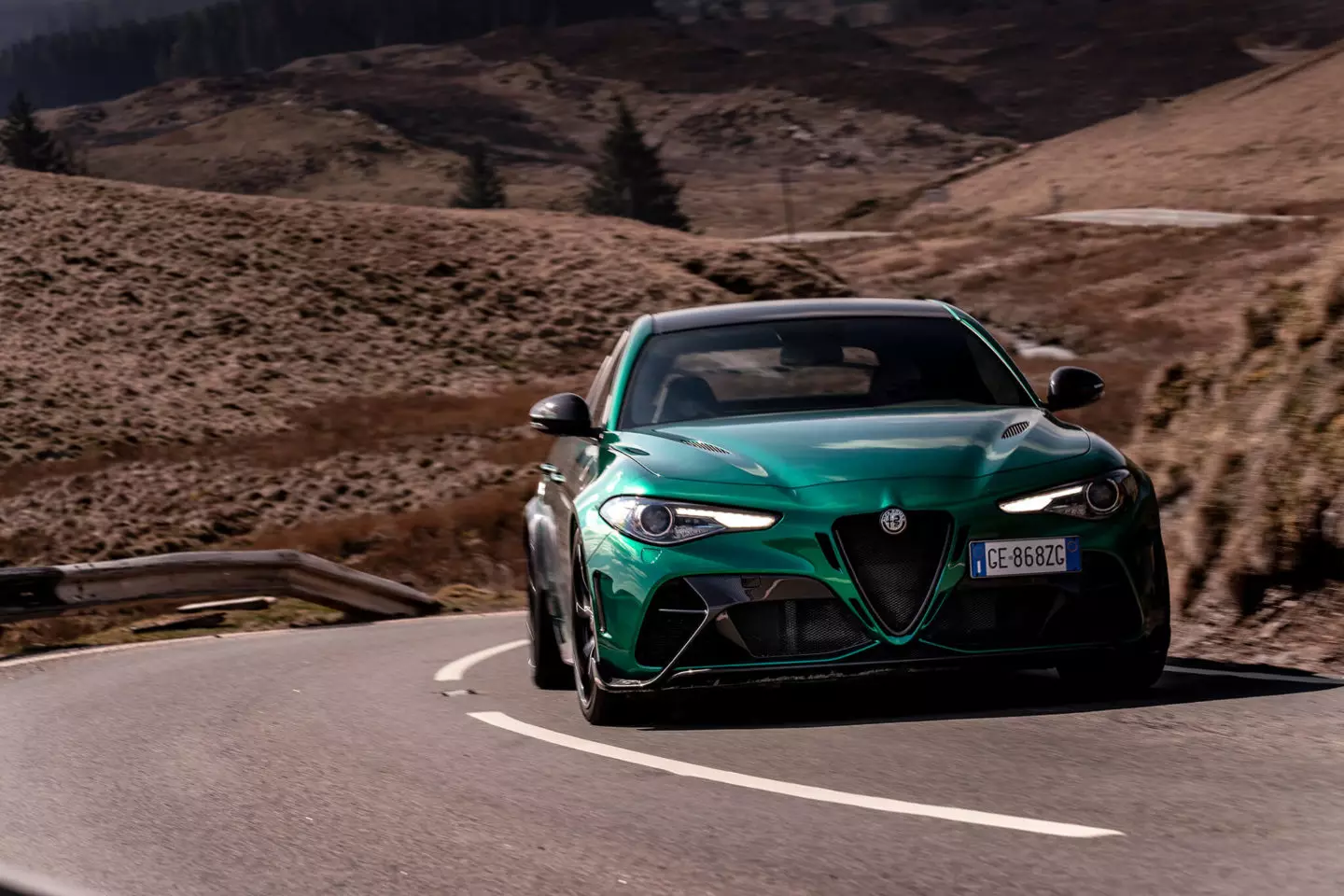
Technical specifications
| Alfa Romeo Giulia GTAm | |
|---|---|
| Motor | |
| Position | longitudinal front |
| Architecture | 6 cylinders in V |
| Capacity | 2891 cm3 |
| Distribution | 2 ac.c.c.; 4 valve per cylinder (24 valve) |
| Food | Injury Direct, Biturbo, Intercooler |
| power | 540 hp at 6500 rpm |
| Binary | 600 Nm at 2500 rpm |
| Streaming | |
| Traction | back |
| Gear box | 8-speed automatic (torque converter) |
| Chassis | |
| Suspension | FR: Independent, overlapping double triangles; TR: Independent, multiarm |
| brakes | FR: Carbo-ceramic disks; TR: Carbo-Ceramic Discs |
| Direction/No. of turns | Electrical assistance/2.2 |
| turning diameter | 11.3 m |
| Dimensions and Capabilities | |
| Comp. x Width x Alt. | 4669 mm x 1923 mm x 1426 mm |
| Length between the axis | 2820 mm |
| suitcase capacity | 480 l |
| warehouse capacity | 58 l |
| Wheels | FR: 265/35 R20; TR: 285/30 R20 |
| Weight | 1580 kg (US) |
| weight sharing | FR-TR: 54%-46% |
| Provisions and consumption | |
| Maximum speed | 300 km/h |
| 0-100 km/h | 3.6s |
| 0-200 km/h | 11.9s |
| 0-1000 m | 21.1s |
| 80-200 km/h | 8.6s |
| Braking 100-0 km/h | 35.5 m |
| Combined consumption | 10.8 l/100 km |
| CO2 emissions | 244 g/km |
